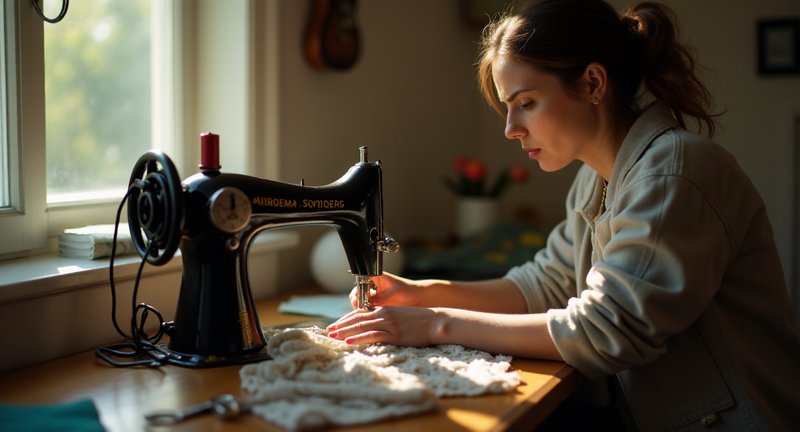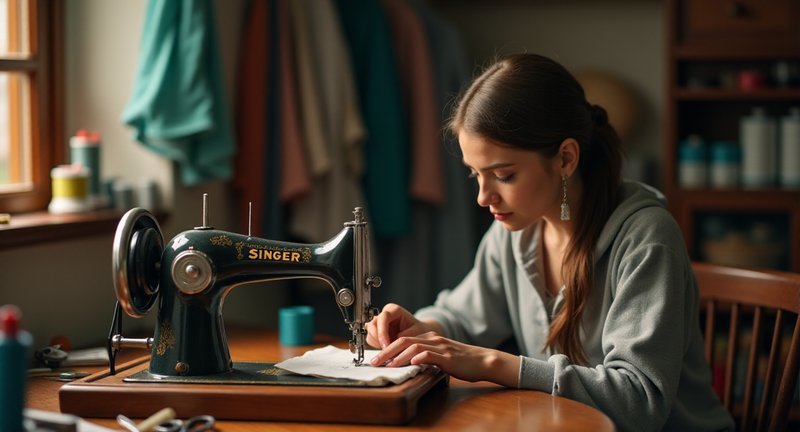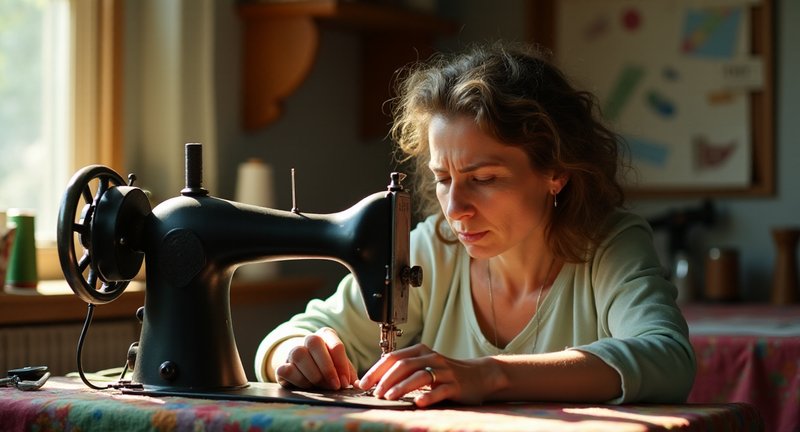Getting Started with Singer Sewing Machine Issues
When I first started my sewing journey, the excitement was palpable, but it wasn’t long before I encountered some pesky Singer sewing machine issues. It’s almost like every seamstress goes through a rite of passage where their beloved machine decides to throw a tantrum. If you’re nodding your head in agreement, fear not! Here are some common problems and how to tackle them, based on my personal trials and tribulations.

Common Problems with singer sewing machines:
-
Thread Tension Troubles: If your stitches look like a jumbled mess, it’s often due to improper tension. Try adjusting the tension dial and see if it helps. Remember, patience is key!
-
Needle Woes: A bent or dull needle can lead to a frustrating experience. Always keep a stash of new needles handy and swap them out regularly. It’s a game changer!
-
Thread Snags: Have you ever experienced thread snags or breakage? This can be caused by old or poor-quality thread. Invest in good thread, and your sewing will glide like a dream.
-
Skipping Stitches: If your machine is skipping stitches, it could be a sign that the needle is improperly installed or you need to change it. Don’t skip this step your sewing project will thank you!
-
Machine Jams: Nothing can halt your creative flow like a jammed machine. Always keep your machine clean and free of lint and debris. A quick maintenance check can prevent this issue from cropping up.
Navigating through these Singer sewing machine challenges may feel overwhelming at times, but remember, every expert was once a beginner. Embrace the journey, and before you know it, you’ll be sewing like a pro!
How to Address Singer Sewing Machine Issues
In the matter of my trusty sewing companion, I’ve had my fair share of hiccups that could make anyone’s fabric-loving heart skip a beat. Here’s how I’ve tackled those little nuisances that can pop up now and then.

Thread Trouble
Ah, the infamous thread tangles! I’ve found that rethreading the machine can often do the trick. Here’s a quick rundown:
- Check the spool: Make sure it’s seated correctly.
- Thread path: Follow the threading path to ensure it’s right.
- Tension settings: Adjust the tension; sometimes it needs a little tweaking.
Needle Mishaps
Let’s face it, a dull needle can ruin a project faster than you can say “sewing disaster.” Here’s how I keep my needles in tip-top shape:
- Regular inspection: Check for bends or dullness.
- Right type: Use the appropriate needle for your fabric type.
- Replace often: I change mine every few projects or when I feel resistance.
Bobbin Blues
The bobbin is like the unsung hero of sewing. If it’s not working, nothing will! Here’s what I do:
- Check for winding issues: Ensure it’s wound evenly.
- Proper placement: Make sure it’s seated correctly in the casing.
- Clean the area: Dust can accumulate, so I always keep it tidy.
Mechanical Mayhem
Sometimes, the machine just doesn’t want to cooperate. When this happens, I usually:
- Oil the moving parts: A drop of oil can work wonders.
- Look for jams: If fabric is stuck, carefully free it.
- Consult the manual: I always keep mine nearby for guidance.
So there you have it! With a bit of patience and these handy tips, I’ve managed to keep my sewing adventures flowing smoothly.
Introduction to Singer Sewing Machines
In the context of the world of sewing machines, I’ve always found myself drawn to the iconic Singer brand. From my first encounter, there was an undeniable allure in their classic design and robust functionality. Let’s take a closer look at why Singer sewing machines have captured the hearts of so many enthusiasts.
One of the standout features is the incredible versatility they offer. Whether you’re an aspiring fashion designer or just looking to mend a pair of jeans, a Singer machine can adapt to your needs. Here’s what I’ve discovered over the years:
- Wide Range of Models: From basic mechanical machines to advanced computerized models, there’s a Singer for every skill level.
- User-Friendly Design: Many of their machines come equipped with intuitive controls and clear instructions, making it easy to get started.
- Durability: Singer machines are built to last, often becoming beloved heirlooms that can be passed down through generations.
But with any beloved tool, there can be a few quirks along the journey. There might be times when you experience some hiccups. Here are some common hurdles I’ve encountered:
- Thread Jamming: It can happen when the threading isn’t quite right. A little patience and re-threading can do wonders!
- Tension Troubles: Finding that sweet spot for thread tension can feel like an art form, but once you nail it, the results are worth it.
- Bobbin Mysteries: Understanding how to load and maintain your bobbin will unlock a whole new level of sewing.
Embracing these challenges is part of the adventure. The key is to approach your machine with curiosity and a willingness to learn. After all, every stitch tells a story, and with Singer, you can craft your narrative one seam at a time.
Understanding Common Sewing Machine Problems
When diving into the world of sewing, there’s a delightful sense of creativity that emerges. However, every seasoned seamstress or eager beginner inevitably encounters some hiccups with their trusty sewing companion. Let me share some common sewing machine conundrums I’ve faced along the way, and perhaps you’ll find a little comfort in knowing you’re not alone.
Common Sewing Machine Problems:
-
Thread Jamming:
- This pesky problem often feels like a scene from a horror movie your thread gets tangled, and you’re left wrestling with a chaotic mess.
- Tip: Check for any broken threads or lint that may have lodged themselves in the bobbin case.
-
Skipping Stitches:
- If your machine decides to skip stitches as if it’s playing a game of hopscotch, it can be frustrating.
- Solution: Ensure your needle is properly installed and not damaged. A fresh needle can work wonders!
-
Fabric Bunching:
- You know that feeling when your fabric looks like a crumpled-up piece of paper? Yeah, not ideal.
- Cause: This often happens if the tension settings are off. Adjusting the tension dial may bring harmony back to your sewing project.
-
Unwanted Noise:
- Ever heard your machine making sounds that resemble a disgruntled cat? It’s time to investigate!
- Action: Lubricate the moving parts according to your machine’s manual. It could be crying out for some love.
-
Needle Breakage:
- When the needle snaps, it feels like the universe has conspired against your project.
- Prevention: Always use the right needle for your fabric type and avoid sewing through multiple layers at once.
Understanding these common sewing machine issues can save you time and frustration. Trust me, a little knowledge goes a long way in keeping your sewing journey smooth and enjoyable!
Thread Tension Troubles
Ah, thread tension a delicate dance that can turn a sewing project into a fiasco faster than you can say “bobbin.” I remember my early days, threading up my machine, only to have the fabric rebel against my intentions. Nothing quite compares to the frustration of a misbehaving thread.
When the tension isn’t just right, it’s like trying to ride a bicycle with flat tires. You may think you’re moving forward, but you’re actually just spinning your wheels in frustration. A loose thread can create those unsightly loops on the underside of your fabric, while a too-tight setting can lead to breakage. It’s a fine line between bliss and chaos.
So, how do we navigate this slippery slope? First, I always recommend checking your machine’s manual. I know it sounds boring, but those pages often hold the secrets to achieving that sweet spot of balance. Also, don’t underestimate the power of a good quality thread. Sometimes, the solution is as simple as changing the spool to something more reliable.
I found that experimenting is half the fun. Adjusting the tension dial can feel like tuning an instrument each tiny change makes a noticeable difference. So, don’t shy away from tinkering until you find that harmonious setting. Remember, sewing is an art, and every artist has their quirks.
In the grand context of sewing, thread tension is just one of those threads that holds everything together. With patience and practice, you’ll soon master this intricate dance and turn potential disasters into beautiful creations. Keep your spirits high, and don’t be afraid to get your hands a little dirty.
Needle and Thread Compatibility Issues
Needle and thread compatibility can feel like navigating a maze. I’ve often found myself staring at my sewing box, wondering why my chosen thread refuses to cooperate with my needle of choice.
When I first started sewing, I learned the hard way that not all threads are created equal. Some threads are like that one friend who just can’t get along with everyone fraying, tangling, and ultimately ruining my fabric bliss. Trust me, it’s best to read the labels and understand which thread pairs well with your needle.
I remember the time I used a thicker thread with a fine needle. The needle protested, bending like a reed in the wind. It was a frustrating moment that taught me the importance of pairing the right needle with the right thread. I learned that for thicker threads, a larger needle is essential; otherwise, it’s just a recipe for disaster.
It’s also fascinating how the type of fabric can affect this compatibility. A delicate silk demands a gentle touch, while a sturdy denim is more forgiving. I’ve often felt like a matchmaker, trying to find the perfect combination that will create harmony in my projects.
So, take a moment to experiment, and don’t be afraid to try different combinations. The beauty of sewing lies in its creativity. Remember, every great seamstress has faced these hiccups embrace them as part of the journey!
Machine Jamming Solutions
Ah, the moment when your trusty sewing companion decides to throw a tantrum, leaving you in a web of threads and frustration! I’ve had my fair share of those days, and let me tell you, machine jamming can feel like a sewing crime scene.
First, let’s talk about the enemy: the fabric. It often plays coy, slipping into the machine at odd angles. I’ve learned to keep my eye on the prize aligning the fabric with precision. It’s like a dance, where both partners need to be in sync.
Another culprit? The thread tension. I’ve found that an erratic tension can turn your sewing project into a spaghetti nightmare. Adjusting the tension dial can be a game-changer, turning chaos into smooth stitches, almost as if your machine is whispering sweet nothings back to you.
If your machine still rebels, it might be worth checking for lurking debris. Dust bunnies love to hide in the nooks and crannies, playing the villain in this saga. A good cleaning can reveal the hidden monsters that cause all that ruckus.
Sometimes, simply rethreading the machine can work wonders. It’s akin to giving it a fresh start like a warm hug after a long day. Don’t underestimate the power of a little TLC; it can bring a machine back to life.
So, next time you find yourself in a tangle, remember these tips. You and your machine can become the perfect duo, crafting beautiful creations together without any drama.
Bobbin Problems and Fixes
When working with bobbins, it feels like a love-hate relationship, doesn’t it? Sometimes, that tiny spool spins smoothly like a dream, and other times it decides to twist and tangle itself into knots. One minute you’re flying through a project, and the next, you’re cursing under your breath, rethreading for the fifth time.
One of the first quirks I notice with bobbins is when the thread tension goes rogue. It’s either too tight, making your fabric pucker up, or too loose, causing the stitches to droop. If you’re anything like me, this is where you take a deep breath and remind yourself that fiddling with the tension dial might just be your best bet.
Then, there are the moments when the bobbin refuses to wind properly. You watch it spinning at an awkward angle, filling unevenly as if it has its own agenda. When that happens, I gently reposition the bobbin, maybe give the thread a little more slack, and most times, it gets back on track though patience is key here.
And, of course, let’s not forget the classic bobbin jamming nightmare. You hear the dreaded clunk, look down, and see a tangled mess beneath the plate. In my experience, cleaning out the bobbin case and checking for any stray bits of lint can work wonders.
Bobbin issues might feel frustrating, but with a little know-how, you can tackle them head-on. Trust me, I’ve been there more times than I’d like to admit!
Uneven Stitching Explained
Uneven stitching is one of those little annoyances that can drive a person to distraction. It starts so innocently, a few uneven loops, a loose stitch here, a tight one there, and before you know it, the entire project looks wonky. The cause? Well, it’s often rooted in something as simple as tension settings.
In my years of sewing, I’ve encountered countless hiccups with machines. Singer Sewing Machine Issues are some of the more frequent ones I’ve come across, particularly when the thread tension isn’t quite right. It’s like the machine has a mind of its own, pulling the fabric just a bit too much or not enough.
Let’s not forget the needle. A dull or bent needle can lead to skipped stitches or uneven patterns. Have you checked yours lately? It’s a sneaky little culprit that can be easy to overlook but can cause major frustration.
Threading, too, plays a part in these little stitching disasters. If your machine is not threaded correctly, your fabric will pay the price. Trust me, even after years of experience, I still have to double-check my threading especially when I’m facing those pesky Troubles with singer sewing machines.
So, if you’re staring at a seam that looks more like a roller coaster than a straight line, take a breath. Most often, it’s an easy fix a tension tweak, a needle change, or a quick rethread. I’ve been there, and I promise you, it’s all part of the journey to becoming a sewing pro.
Skipped Stitches Solutions
Skipped stitches can be a headache for anyone working on a sewing project. They interrupt the flow, leaving behind gaps that can weaken your seams. I’ve had my fair share of battles with skipped stitches, and through trial and error, I’ve picked up a few handy solutions to get things back on track.
First things first check your needle. It’s the most common culprit when stitches start to skip. Even a slightly bent or dull needle can cause issues. Replace it regularly and ensure you’re using the right type for your fabric. If you’re working with thick materials like denim, opt for a heavier needle.
Another overlooked factor is thread tension. If it’s too tight or too loose, your machine won’t sew properly. Try adjusting the tension dial start small and test on a scrap piece of fabric before diving back into your project. Also, don’t forget to re-thread both the top and bobbin threads. Sometimes, they just need to be reset.
Let’s not forget the importance of proper foot pressure. If your presser foot isn’t applying enough pressure, the fabric won’t feed through smoothly, causing skips. Adjusting the pressure, especially when working with layers, can make all the difference.
Also, consider cleaning your machine. Dust and lint can gather in the bobbin case or around the feed dogs, blocking smooth movement. It’s surprising how much a little maintenance can improve stitch quality.
Here’s a quick recap:
- Change your needle regularly.
- Adjust thread tension carefully.
- Check presser foot pressure.
- Clean your machine routinely.
If you follow these steps, you’ll be back to stitching smoothly in no time. Skipped stitches may be frustrating, but with a little care, you can easily avoid them.
The Full Scope of Singer Sewing Machine Issues
With regard to using a Singer sewing machine, there’s more than just threading the needle and pressing the pedal. Over time, you start to notice little quirks that seem harmless at first, but eventually, they begin to hinder your sewing flow. It’s like the machine has a personality of its own, and sometimes, it simply doesn’t want to cooperate.
I’ve had my fair share of those head-scratching moments. You know, when the thread keeps tangling, or the needle refuses to catch the bobbin thread. It’s frustrating, especially when you’re in the middle of a project that needs to be finished yesterday. But the silver lining? Most of these problems have straightforward fixes, once you understand what’s going on.
Sometimes, it’s all about the tension too tight, and the stitches pull. Too loose, and they’re just a mess. Other times, it’s as simple as cleaning out the lint that has been collecting in the machine’s crevices. A little maintenance goes a long way, but honestly, sometimes it feels like a secret language you need to learn.

And let’s not forget about those rare instances when the machine makes a noise that doesn’t belong. That ominous clicking or grinding? It’s your sewing machine’s version of a warning light, telling you it’s time to investigate. Trust me, ignoring those sounds never leads to anything good.
So, while working with a Singer sewing machine can feel like an art form, getting to know its ins and outs will save you from a lot of unnecessary frustration.
Foot Pedal Malfunctions
Considering sewing, the foot pedal is your primary control for speed and precision. So, when that little guy starts acting up, it can throw off your whole project. I’ve had my fair share of foot pedal troubles, and let me tell you, it’s a frustrating experience but not one without a fix.
First, one of the most common issues is unresponsiveness. You press down, and nothing happens, or it takes a lot more effort than it should. This could be a sign of loose wiring, which can happen over time. You may want to check the connections inside the pedal, but be cautious always unplug the machine before doing any tinkering.
Another frequent problem is inconsistent speed control. You may press lightly, but the machine roars to life as if you floored it. This erratic behavior often points to worn-out potentiometers inside the foot pedal. Replacing or cleaning them might be necessary, depending on the model.
Now, if your foot pedal starts heating up or smelling like it’s about to catch fire, stop immediately! This could indicate a short circuit or faulty insulation. Never ignore this kind of malfunction it’s a fire hazard and should be addressed by a professional.
To sum it up, here are a few things to check if your foot pedal is acting up:
- Unresponsive? Inspect the wiring.
- Inconsistent speed? Check the potentiometers.
- Smells or heats up? Stop and seek professional help.
Foot pedal malfunctions are annoying, but they’re not the end of the world. A bit of troubleshooting can go a long way, and you might just save yourself a costly replacement.
Electrical Issues with Sewing Machines
Ah, electrical issues with sewing machines – they can be frustrating, right? You sit down, ready to create something beautiful, and suddenly… nothing. But don’t worry, I’ve been there. Over the years, I’ve seen some common problems crop up that are often easier to fix than you’d think.
Let’s break it down:
-
Power Cord Woes: One of the first things to check is the power cord. These cords can fray, especially if they’ve been coiled and uncoiled repeatedly. If you spot any wear, you’ll want to replace it ASAP. A damaged cord can cause inconsistent power flow or no power at all.
-
Foot Pedal Glitches: The foot pedal is your speed control, and when it misbehaves, it can feel like your machine has a mind of its own. Sometimes, cleaning out dust or debris from inside the pedal can make a world of difference. Other times, it could be an internal wiring issue, which might require a professional to sort out.
-
Motor Burnout: Now, this one’s a bit more serious. If your sewing machine makes a loud hum but the needle doesn’t move, your motor might be shot. While this can sound like a disaster, motors can be replaced. It’s not always cheap, but it’s better than buying a whole new machine.
-
Loose Wiring Connections: Machines can vibrate loose over time. A common issue is a loose wire somewhere inside the machine. Opening up your machine (carefully) and ensuring all the wires are secure might solve the problem. It’s a bit tricky but not impossible if you’re comfortable working with electronics.
And trust me, when you finally hear that sweet hum of a working machine again, it’ll be totally worth it.
Maintenance Tips to Prevent Problems
Maintaining your sewing machine isn’t just about keeping it running smoothly, it’s about prolonging the life of a trusted companion. I’ve learned that little regular habits go a long way in preventing those headaches that seem to pop up at the worst times.
First off, clean your machine frequently. Even if it looks spotless on the outside, dust and lint sneak inside. It’s like they have a mind of their own, building up in the bobbin area. A small brush can work wonders.
Oiling is another unsung hero of maintenance. I used to think this was optional, but skipping it left me with a creaky machine. A drop or two in the right spots keeps everything humming along nicely.
One thing I wish I had known earlier: always use the right needle for the fabric. It’s so easy to overlook, but mismatched needles can lead to a world of frustration. Take it from me, it’s worth the few extra seconds to check.
And don’t underestimate the power of a well-wound bobbin. A loose or uneven bobbin can turn sewing into a battle. It’s a small step, but it prevents big problems.
As a matter of fact, give your machine a break. I’ve learned not to push mine too hard on large projects without giving it time to cool down. It needs rest just like we do. Trust me, a little downtime now can save you a lot of repair time later.
Cleaning Your Singer Sewing Machine
Maintaining your Singer sewing machine isn’t just about performance, it’s about keeping it purring like a contented cat. I’ve been sewing for years, and let me tell you, a clean machine can make all the difference when you’re stitching away on a project. Dust, lint, and fabric fuzz are like the silent villains lurking inside your machine, just waiting to cause havoc. So, let’s tackle that!
Start by unplugging the machine. I know this sounds basic, but trust me, it’s an easy step to forget. Then, remove the needle and presser foot. It’s also a great idea to slide out the bobbin case while you’re at it.
Here’s a simple step-by-step guide to follow:
-
Brush away the lint: Grab a small brush (a soft-bristled one works best) to clear out the fuzz that tends to build up around the feed dogs, bobbin case, and throat plate. You might find lint hiding in places you wouldn’t expect!
-
Use compressed air sparingly: It’s tempting to blast the lint away with a puff of air, but be cautious. Too much air can push debris deeper into the machine. If you do use it, keep the nozzle at a distance.
-
Oil the right spots: Singer machines love a little TLC in the form of oil. A tiny drop of sewing machine oil on the moving parts can keep it running smoothly. Just remember to follow the manual for oiling guidance it’s like feeding your machine a healthy diet.
-
Wipe it down: Finish by giving the exterior a gentle wipe with a microfiber cloth. It keeps your machine looking as good as it sews!
Now, put everything back together and give it a test run. You’ll notice how much smoother everything feels. Regular cleaning isn’t just maintenance it’s a secret weapon to keeping your creative flow uninterrupted.
Frequently Asked Questions
What are the 7 common sewing machine troubles?
Common sewing machine troubles include thread bunching or tangling, skipping stitches, the needle not moving, the machine jamming, thread breaking, inconsistent tension, and the machine not feeding fabric properly. Each of these issues can stem from various causes, such as improper threading, incorrect needle choice, or a need for maintenance. Recognizing these problems early can save time and effort, ensuring a smoother sewing experience.
Why is my Singer sewing machine bunching thread on the bottom?
If your Singer sewing machine is bunching thread on the bottom, it may indicate a few potential issues. Often, this problem arises from incorrect threading of the machine or the bobbin. Make sure the thread is properly loaded and the bobbin is wound evenly. Additionally, a dull or bent needle can cause thread bunching, so check your needle and replace it if necessary. Regular maintenance and proper threading techniques are crucial for smooth operation.
Why is my Singer sewing machine not sewing correctly?
When your Singer sewing machine isn’t sewing correctly, several factors could be at play. Common issues include a misthreaded machine, incorrect needle size, or an unsuitable stitch type for your fabric. The tension settings may also need adjustment, as incorrect tension can lead to poor stitch quality. Inspect your machine for any obstructions or debris, and ensure it is clean and oiled. Troubleshooting these areas usually resolves the problem.
What is the life expectancy of a Singer sewing machine?
The life expectancy of a Singer sewing machine varies widely based on usage, maintenance, and model. Generally, a well-maintained Singer sewing machine can last 10 to 25 years, or even longer with regular care. Machines that are used frequently or for heavy projects may require more maintenance and could wear out sooner. Investing in quality care, such as routine cleaning and professional servicing, can extend the machine’s lifespan significantly.
Why is my thread looping underneath?
Thread looping underneath the fabric typically indicates issues with threading or tension. Ensure the upper thread is threaded correctly and that the presser foot is up when threading. If the tension is too loose, it can lead to loops, so check the tension settings and adjust accordingly. Additionally, a damaged or improperly inserted needle may cause looping, so replacing the needle may be necessary to resolve the issue.
Why is the thread not going through fabric?
If the thread is not going through the fabric, it may be due to a few common problems. First, ensure that the needle is inserted correctly and that you are using the appropriate needle type for the fabric. If the needle is dull or damaged, it won’t penetrate the material properly. Also, check the machine settings, including stitch length and tension, as incorrect settings can prevent the thread from sewing effectively.
Why does my sewing machine keep jamming underneath?
A sewing machine jamming underneath can be frustrating, and it often occurs due to thread tangling or debris buildup. Check for tangled thread in the bobbin area or around the feed dogs, which may need to be cleared. Another common cause is using the wrong type of needle for your fabric, which can lead to jams. Regular cleaning and maintenance, including oiling and checking for lint accumulation, can help prevent this issue.
Why is my sewing machine getting tangled underneath?
If your sewing machine is getting tangled underneath, it often relates to improper threading or tension issues. Start by rethreading the machine, ensuring the upper and bobbin threads are correctly set. If the tension is too tight or too loose, it can cause tangles, so adjust the tension settings as needed. Also, inspect the bobbin case for any debris or damage, which could contribute to tangling while sewing.
Why is my thread nesting underneath?
Thread nesting underneath typically results from incorrect tension settings or a misthreaded machine. When the upper tension is too loose, it can lead to nests forming as the machine struggles to pull the thread evenly. Ensure that the machine is threaded correctly and that the bobbin is wound and inserted properly. Additionally, check your needle for any defects, as a faulty needle can also contribute to this issue.
Why is my sewing machine skipping stitches and breaking thread?
Skipping stitches and breaking thread can be caused by several factors. One common reason is a dull or damaged needle; replacing it can often resolve the problem. Incorrect tension settings may also cause skipped stitches, so ensure the tension is appropriately set for your fabric. Additionally, make sure you’re using the correct thread type for your machine, as some threads are more prone to breaking than others.
What are the six sewing machine troubles?
The six common sewing machine troubles include thread tension issues, needle problems, fabric feeding difficulties, thread breakage, machine jamming, and inconsistent stitch quality. Each of these issues can usually be traced back to threading errors, improper needle choice, or lack of maintenance. Identifying and addressing these problems early on can lead to a smoother sewing experience and extend the life of your machine.











I can totally relate to your experience with Singer sewing machines! When I first started sewing, I felt like my machine had a personality of its own one minute it was my best friend, and the next, it was throwing tantrums! The thread tension issue was particularly daunting for me. I found that using a quality thread made a world of difference, just like you mentioned. I also learned the hard way about needle maintenance; it really is a game changer to keep a stash of new needles handy! As for machine jams, I’ve turned that into a little ritual cleaning out the lint and debris has become a meditative moment for me. I guess we all have our ways of navigating these challenges, and it’s great to hear I’m not alone in this sewing journey! Happy stitching!